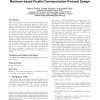Free Online Productivity Tools
i2Speak
i2Symbol
i2OCR
iTex2Img
iWeb2Print
iWeb2Shot
i2Type
iPdf2Split
iPdf2Merge
i2Bopomofo
i2Arabic
i2Style
i2Image
i2PDF
iLatex2Rtf
Sci2ools
ICS
2009
Tsinghua U.
2009
Tsinghua U.
Towards 100 gbit/s ethernet: multicore-based parallel communication protocol design
Ethernet line rates are projected to reach 100 Gbits/s by as soon as 2010. While in principle suitable for high performance clustered and parallel applications, Ethernet requires matching improvements in the system software stack. In this paper we address several sources of CPU and memory system overhead in the I/O path at line rates reaching 80 Gbits/s (bi-directional), using multiple 10 Gbit/s links per system node. Key contributions of our work are the design of a parallel high-performance communication protocol that uses context-independent page-remapping to (a) reduce packet processing overheads; (b) reduce thread management and synchronization overheads; and (c) address affinity issues in NUMA multicore CPUs. Our design result in the full 40 Gbits/s of available one-way Ethernet bandwidth and in 57.6 Gbits/s (72%) of the 80 Gbits/s maximum bidirectional throughput (limited only by the memory system), while leaving ample CPU cycles for application processing. Categories and Subje...
| Added | 20 May 2010 |
| Updated | 20 May 2010 |
| Type | Conference |
| Year | 2009 |
| Where | ICS |
| Authors | Stavros Passas, Kostas Magoutis, Angelos Bilas |
Comments (0)

